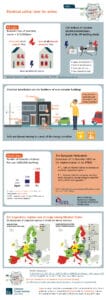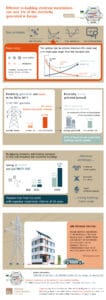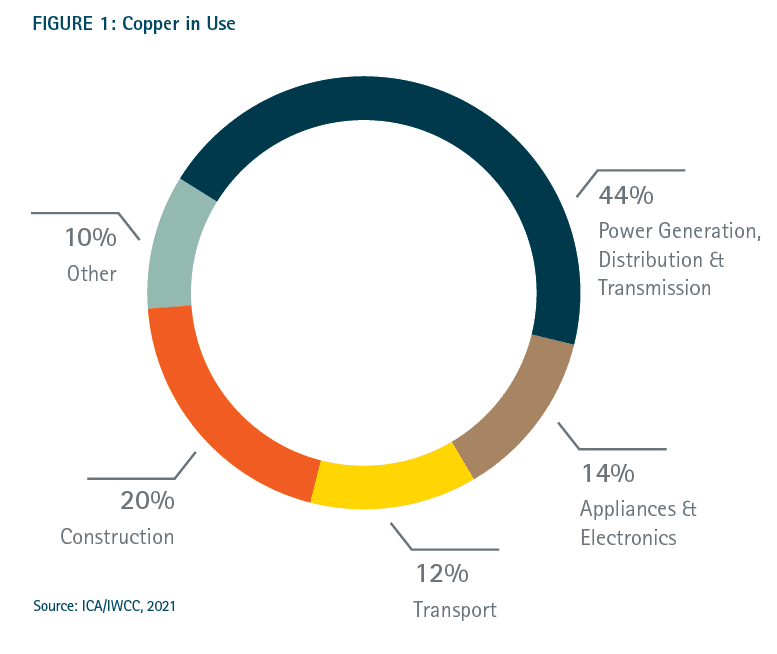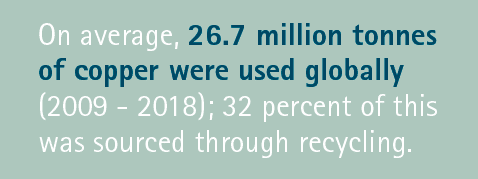After 16 days, the Olympic flame was slowly extinguished on 20 February 2022 at Beijing’s National Stadium to mark the closing ceremony of the XXIV Olympic Winter Games. While global athletes won praise at the podium, copper technology was working behind the scenes to provide safe and sustainable Olympic venues powered by clean energy and to help bring the Olympics to homes across the world through 5G broadcasting technology. International Copper Association (ICA) member KGHM also supported Olympic athletes in the lead-up to the games through its “Copper Rivalries” sponsorship program. Whether on or off the podium, copper played an essential role in the 2022 XXIV Olympic Winter Games.
Olympic Stadiums and Venues Constructed with Copper
In the construction of the stadium and venues for the Winter Olympics, Jiangxi Copper Co., Ltd., (“Jiangxi Copper”) contributed as an upstream supplier. Zhejiang Ship Group Co., Ltd., was the provider of structured cable systems and services, including data cables, fiber cables, modules and jumpers for a dozen key venues, such as the National Stadium, the National Speed Skating Oval and the Olympic Village. Jiangxi Copper supplied more than 80 percent of the main material for cables used by the Ship Group.
Providing Clean Energy to Power the Games
The National Wind-Solar Storage and Transportation Demonstration Project located in Bashang Area of Zhangjiakou is home to many massive windmills. Each 100-meter-tall (328 ft) tower supports three blades that are 62 meters (203 ft) long. Beneath these windmills, rows of PV panels operate day and night to generate electricity, which was distributed via the state grids to power the Winter Olympics venues.
Copper is a basic material in the support of the clean energy transition. It plays a vital role in creating a greener future, as renewable energy systems can use up to 12 times more copper than traditional systems. Every year, newly implemented wind power facilities use 550,000 tonnes of copper. As a 100 percent recyclable material, it is also a sustainable choice and contributes to the circular economy.
At a press conference, Foreign Ministry spokesperson Zhao Lijian stated that 26 venues in the three main competition zones were 100 percent powered by green energy—the first time ever in Olympic history. A key portion of the green power was generated from the wind projects in Zhangbei and solar projects in Bashang.
5G Olympics: Copper Technology Makes 5G Broadcast Possible
The “Beijing Winter Olympics has set new records in terms of broadcasting hours, digital media performance and online live-streaming performance,” said Timo Lumme, Managing Director of IOC Television Marketing Services (TMS), at a press conference titled “Broadcasting and Media Data.”
Assisted by 5G and cloud broadcasting technologies, the core systems of the Beijing Olympics were “100 percent cloud based,” a new achievement in the history of the Olympic Games. China Unicom provided a 5G network with an average 200M bandwidth with 300M bandwidth in some indoor venues. From the National Alpine Skiing Centre and Big Air Shougang to the Ice Cube Skating venue, global audiences were able to enjoy live streams of the Olympic events as a result of the 5G technologies, including opportunities to have immersive, birds-eye view coverage of the sporting events. Printed circuit boards (PCB) and their copper-clad laminate (CCL) are essential components to the development and operation of 5G technologies. Copper’s high-conductivity, corrosion resistance and recyclability make it the material of choice in these applications.
ICA Member KGHM Sponsors Olympic Athletes
There would be no Olympic games without the exceptional performance and dedication of its athletes. ICA member KGHM has a long history of supporting athletes, and the 2022 Winter Games was no different. KGHM sponsored several of Poland’s national athletes, including alpine skier Maryny Gąsienicy-Daniel who competed in the Women’s Super-G, Women’s Giant Slalom and the Mixed Team Parallel events. She finished in the top ten in the last two events. KGHM also supported speed skater Natalia Czerwonka who competed in the Women’s 1500m and Women’s Team Pursuit events, where she finished 8th.
Through its “Copper Rivalries” program launched in 2019, KGHM has provided financial support to top athletes in conjunction with the Polish Ministry of Culture, National Heritage and Sport. Each year, more than 20 athletes receive sponsorship from KGHM, including Olympians from the Summer Olympic games in Rio de Janeiro and Tokyo. KGHM is also committed to strengthening winter sports, sponsoring the 46th Piast Race, a cross-country skiing festival with over 5,000 competitors from 21 countries that takes place after the Olympic games. In addition, the company has developed numerous youth sports programs, including the Zagłębie Lubin Football academy, which trains nearly 400 junior athletes every day and has had notable sporting success in junior leagues.
Bronze Medal Tallies
The medals’ ceremony is an iconic Olympic moment. Copper’s most prominent role at the Winter Olympics was the bronze medal itself, which is made of 95 percent copper. At the 2022 Winter Olympics, Norway took home the highest number of medals overall and the most gold medals, but both Canada and the Russian Olympic Committee were able to eclipse the Norwegian bronze medal tally (13 bronze medals), taking home 14 bronze medals each.
The global inspiration, messages of unity and peace, and progression of sport that the Olympics provide have captured the imagination of people across the world for centuries. ICA and its members are proud of copper’s contributions to the Olympic story, helping to bring the world together, sustainably.






